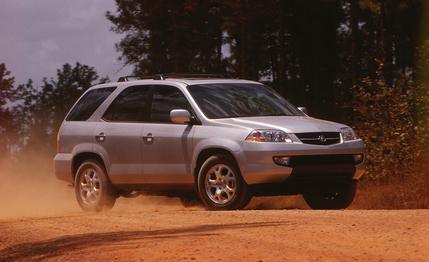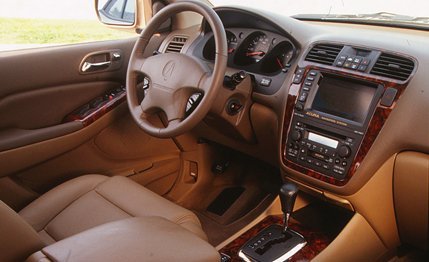
 First Drive Review
First Drive Review


Led by the hot-selling 3.2TL sedan, the introduction of a more powerful CL coupe, and the prospect of an all-new Integra on the near horizon, Acura is on a certifiable roll. Missing, though, is the one model almost every automotive lineup must have: a sport-utility vehicle. Sure, there was—until this year, anyway—the rebadged Isuzu Trooper sold as the Acura SLX, although no one expected that stopgap to last as long as it did. But the company was constrained by overtaxed research and development resources, busy with the development of the CR-V and Odyssey for Honda and the TL and CL for Acura.
Acura's marketing department was not easily put off. Research suggested that as many as 25 percent of Acura customers went looking for sport-utes in other showrooms. Something had to be done.
Manufacturing capacity was found at the plant in Alliston, Ontario, where the Odyssey minivan is built—although that seems amazing, as Honda is selling every Odyssey it can crank out. The minivan platform, with much modification, could be used as the starting point for an SUV. Power would come from a 3.5-liter VTEC V-6 with a creditable 240 horsepower. And somehow, room would be found for seven seats.
Engineers had the advantage of being able to benchmark almost every SUV on the market and aimed the 2001 MDX model at a specific segment: luxury buyers shopping for a mid-size sport-ute such as the Mercedes ML320 and the Lexus RX300. They would want carlike comfort and nimble performance but would be willing to give up truckish features such as a low-range transfer case, some amount of towing capacity, and boulder-traversing off-road-ability.
And they might have a young family—80 percent of the expected customers are married, which makes the small two-person rearmost row (which, as in the Odyssey, folds flat into the floor when not in use) a compelling feature.
The result is the 2001 Acura MDX, which goes on sale this fall starting at about $34,000. As with the 3.2TL, that is a fully loaded price, with only two major options available—a $2000 navigation system and a Touring package that gets you a roof rack, different (but still 17-inch) alloy wheels, a memory for the driver's-seat position, a tilt-down-in- reverse passenger-side mirror, and an upgraded Bose eight-speaker stereo with an in-dash six-CD changer, instead of the standard seven-speaker, single-CD system.


With the nav system and Touring package, expect a price of about $37,000. Even without, the MDX is hardly a stripper, with standard features such as full power controls, side airbags, four-wheel disc brakes with ABS, fog lights, heated mirrors, a trip computer, and wood trim.
Outside, the MDX is purposeful if slightly slab-sided. Some of the nicest touches, such as exterior vertical door sills that don't protrude enough to dirty your pant legs as you enter or exit, are not obvious. Typical for Honda, little new ground is broken here, but the MDX, designed at Honda's studio in Torrance, California, is not unattractive.
Inside, the leather-trimmed front seats are comfortable and supportive, even over long distances. The middle row is reasonably hospitable, with good headroom and adequate kneeroom. The little twin back seats, though, are best reserved for chil-dren or adults on their way to a munchkin audi-tion, but they're still two more seats than you'll find in a Lexus or Infiniti SUV.
The instruments and controls are sensibly placed and easy to use. One problem: MDXs that don't have a navigation system still come with the seven-inch LCD viewing screen. It shows settings for heating and air conditioning, a big electronic compass, and a few other features, but the display looks awkward. Besides, Acura's 48-state nav system is among our favorites, so we'd opt for it.
The neatest thing about the MDX's interior is the clever seating possibilities. The seats fold to allow for two, three, four, five, six, or seven persons. For rear passengers, a heater, an evaporator, and a blower are located in the center console.